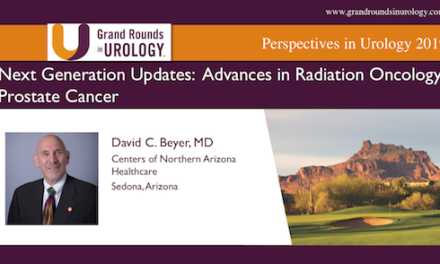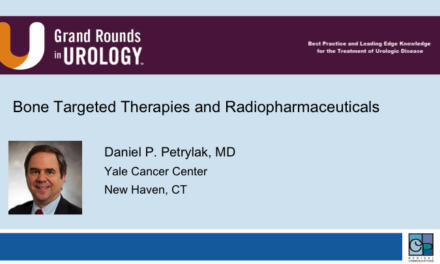Keywords: neuroendrocine prostate cancer, ADT, adenocarcinoma, phenotype, AURKA Kinase
How to cite: Pinthus, Jehonathan.”Neuroendocrine Prostate Cancer (NEPC): Are We Selecting For It With Our Current Androgen Annihilation.” Grand Rounds in Urology. January 22, 2016. Jan 2025. https://dev.grandroundsinurology.com/prostate-cancer-jehonathan-pinthus-neuroendocrine-prostate-cancer/.
Trancript
I was asked by Dr. Crawford to also deliver a talk about the neuroendocrine differentiation in prostate cancer patients and I think this is a very important topic because what you heard for example in this morning’s seminar is how well we can inhibit and deprive androgens and actually Dr. Crawford, himself, stands behind the concept of androgen annihilation but what we are causing and I hope you did understand that from the, or get that from the previous talk is that we’re causing particularly in significant cardiovascular disease, and the other risk, which is completely unrelated to cardiovascular disease is the emergence or neuroendocrine prostate cancer and I think we’re going to see it more and more and more and this is a concern.
So neuroendocrine cells, neuroendocrine cells are part of normal prostate. You cannot see them without specific staining, for example for chromogranin-A or synaptophysin but they are always there as part of the cellular mock up of the prostate and they have some dendritic processes and they are capable of secreting hormones that are trophic and potentially effect their neighboring cells in a – – manner such as bombesin, calcitonin, parathyroid like hormone, and so forth and so on.
So there are three types of neuroendocrine prostate cancer. There is the primary, the neuroendocrine prostate cancer some of that shows up at diagnosis with for example small cell carcinoma. This is a very rare, less than 1%. There are several types. Small cell carcinoma is the most common. Large cell neuroendocrine carcinoma, carcinoid, and so forth, patients are usually present with visceral bulky, soft tissue metastasis that do not respond to a hormonal therapy, they have a very, usually low levels of PSA and high levels of neuroendocrine markers such as chromogranin-A and the treatment is chemotherapy.
The second type of neuroendocrine differentiation, which is more common is neuroendocrine differentiation – – of neuroendocrine cells within the prostate detected in 5 to 10% of prostatic adenocarcinoma that contains some aggregates of neuroendocrine like malignant cells. Those are actually malignant cells. If you do a laser capture dissection of these cells, you can see that they are malignant and they actually have genetic linkage or similarity to the adenocarcinoma cells neighboring to them for example the gene fusion and I’ll show you some data on that. The significance, a prognostic significance of finding this is not very clear. There are some papers that show that it does bear prognostic significance potentially in patients who were undergoing radiation therapy.
The most common type and the thing that I am potentially alarming you today that we are going to see more and more with better modes of androgen deprivation therapy is the secondary development of neuroendocrine cancer. So this is very common. It is actually now estimated to be about 25% of lethal prostate cancer and I’ll show you some data on that. This is actually a result of transdifferentiation of adenocarcinoma cells, epithelial plasticity common progenitor cell under the pressure of ADT and chemotherapy. Those are resistant to ADT but they can also contribute to the tumor genicity of the adenocarcinoma cells because they can secrete trophic hormones and pro oncogenic hormones.
Now how common is it? This is a very interesting abstract that was shown in ASCO. This group, what they did is they evaluated 237 metastatic signs of disease in 187 patients. None of the patients had small cell carcinoma but they investigated with immunohistochemistry to chromogranin-A and synaptophysin and they could show that in 50% of the metastatic sign, they were positive for neuroendocrine cells. And this was in about 44% of hormone sensitive and 55% of prostate cancers. So if you look for that, you’ll find it and interestingly enough, there’s also some data on circulating tumor cells in patients with castration resistant prostate cancer and you can see that in about 10% of them, you can detect neuroendocrine malignant cells – – circulating tumor cells.
So, is it because transdifferentiation from epithelial like phenotype to neuroendocrine like phenotype under selective pressure? Well, you can manipulate adenocarcinoma cells such as LNCaP for example, deprive them from androgens and these are experiments that were done first by – – and you can see actually that when you deprive adenocarcinoma cells from androgens for quite a long time you can develop a neuroendocrine phenotype and more so you can get a neuroendocrine phenotype in prostate cancer cells if you expose them chronically to Docetaxel. So imagine potentially what we are doing now with the Sweeny data and regimen.
A transdifferentiation. That occurs under selective pressure. So we take our adenocarcinoma patients and we treat them justly with ADT. The neuroendocrine cancer cells do not have the androgen receptor. They are deficient in cell regulators to P53, RB1.
They over express cell cycle genes that can let them go into a more aggressive malignant phenotype and I will talk about the AURKA Kinase A and interestingly enough if you look at the splice variants which we talked about I believe yesterday. They are also associated with up regulation or neuroendocrine genes. So we do induce that and the reason molecular machinery, just be very brief here because I just want you to know that there is a molecular – – and phenotype that pushes adenocarcinoma cells into neuroendocrine cells.
For example there is up regulation of PCDH which are a family of – – genes that are – – Y chromosome and what they do, they are genes that induce neuron specific genes such as neuroendocrine phenotype and you can see it here. If you deprive androgens, you can see that there is down regulation of this genes, and this depends – – time.
So, is the plasticity induced by the selective pressure reversible. Well, maybe. We know that in patients with small cell lung cancer that are treated with EGFR mutation, non small cell lung cancer, they can develop small cell lung cancer if you expose them to EGFR inhibition and this is reversible. But we do not know if this is something that is true for prostate cancer.
So molecular machinery, RB loss, MYC over expression, PCHD up regulation, AURKA Kinase over expression. I will go a little bit about that and down regulation of RE1-silencing factor or REST, this is something that we know that happens when you deprive androgens from adenocarcinoma cells.
Is it happening because of common progenitor? The answer is potentially yes. If you take the FVB – – TRAMP mice that has come to death very very rapidly compared to the regular TRAMP cells, you can see and they come to death from neuroendocrine carcinoma. You can see that there is indeed a common progenitor for either the neuroendocrine cells and the adenocarcinoma. So there are cells in the prostate, progenitor cells that the differentiate into the two phenotype depending on the pressure that is applied.
ERG rearrangement. Well, if you look into that, it’s very common. About 50%, sorry, about 83% of patients with neuroendocrine carcinoma and adenocarcinoma cells have in both compartments, ERG – – rearrangement so it’s a common progenitor. So the same cells. We ourselves investigated that. This is a xenograft that we have established from a patient that had originally, sorry, adenocarcinoma cell, sorry prostate cancer under ADT developed small cell carcinoma differentiation into small cell carcinoma. In that phase we did a channel TRP took some of his prostate, implanted it in mice and got a xenograft named WISH-PC2 and what’s interesting here, you can see that when we implanted the tumor tissue, it’s still had some response to androgens although and this is even without having the androgen receptor and this relates to the fact that neuroendocrine cells can have effect on other cells of prostate cancer that would have the androgen receptor secretes – – for example and induced an indirect effect on the surrounding stroma. And this model actually reflects very well to human disease. You can see here in the mice, they have visceral metastases here in the liver. They have lytic lesions in their bone and this is an excellent model to study neuroendocrine cancer.
So, neuroendocrine cells, they can be malignant but more than the fact that they are malignant, they are hormonally functioning. They have an intraepithelial regulatory function. They secrete alternative growth factors such as bombesin, serotonin, somatostatin, calcitonin, parathyroid hormone related protein and if you will they fuel the adenocarcinoma cells that they are now deprived from androgen in a nonandrogen receptor – – away. So having neuroendocrine mixed with adenocarcinoma is a bad thing.
So how can you treat that and this is a very interesting and this is novel data. So AURKA Kinase has been found to be up regulated neuroendocrine cells. You can see it here in a very significant amount of the tumors. Interestingly enough, patients have developed neuroendocrine carcinoma of the prostate do have already AURKA Kinase up regulation in their adenocarcinoma cells as well.
Why is that important? Because you can inhibit this neuroendocrine cells by specific AURKA Kinase A inhibitor and this works in mice but interestingly enough, there is a clinical trial that I think completed the recruitment now. You can find it in clinical trial – – . It’s an orally administered AURKA Kinase A inhibitor. What it does, it inhibits very well, it showed very successful preclinical results, yeah, I’m wrapping up and this trial is now ongoing. It will look into progression of neuroendocrine cells or – – prostate cancer and interestingly enough you can potentially even give it as a prevention.
So the take home messages, or I like to call it cognitive doggy bag. Neuroendocrine prostate cancer developed from adenocarcinoma of the prostate. The prostate is a result of selective pressure, ADT, is that, ADT or cytotoxic agents and involve specific molecular pathways. So for example PCDH, AURKA Kinase and REST, I didn’t have time to go over all. There is an increased incidents of neuroendocrine prostate cancer in the current era of novel ADT agents. It’s suspected, we do not have data, what happened with enzalutamide or abiraterone but it is suspected when you go and do biopsies of metastatic site they secrete alternative growth factors and as such can fuel the growth also of adenocarcinoma cells but hopefully we will have potentially targeted therapy AURKA Kinase inhibitors. Thank you.
ABOUT THE AUTHOR
Dr. Pinthus is an Associate Professor in the Department of Surgery’s Division of Urology at McMaster University in Hamilton, Ontario. He is a surgical oncologist-urologist who completed his MD at the Hebrew University in Jerusalem, Israel, and his urology training at the Sheba Medical Centre at Tel Aviv University in Israel. He then completed 2.5 years of an SUO-accredited Fellowship in Uro-Oncology at the University of Toronto. Dr. Pinthus earned his PhD at the Weizmann Institute of Science in Rehovot, Israel, working on gene immunotherapy of prostate cancer.
He is heading a basic and translational research laboratory at McMaster University and his research interests relate to how patients’ individual host factors and metabolism affect prostate cancer growth and response to therapy. Dr. Pinthus has published more than 80 peer-reviewed papers and several book chapters. He is a member of the editorial board of European Urology, Prostate Cancer, and Prostatic Disease. Dr. Pinthus is the principal investigator on many distinguished research grants, including a $3.5 million Movember-Prostate Cancer Canada grant titled “Role of androgen deprivation therapy in cardiovascular disease - a longitudinal prostate cancer study (RADICAL PC).” This study is intended to prospectively address the potential link between prostate cancer in general and androgen deprivation therapy (ADT) in particular and an increased risk of cardiovascular disease.





